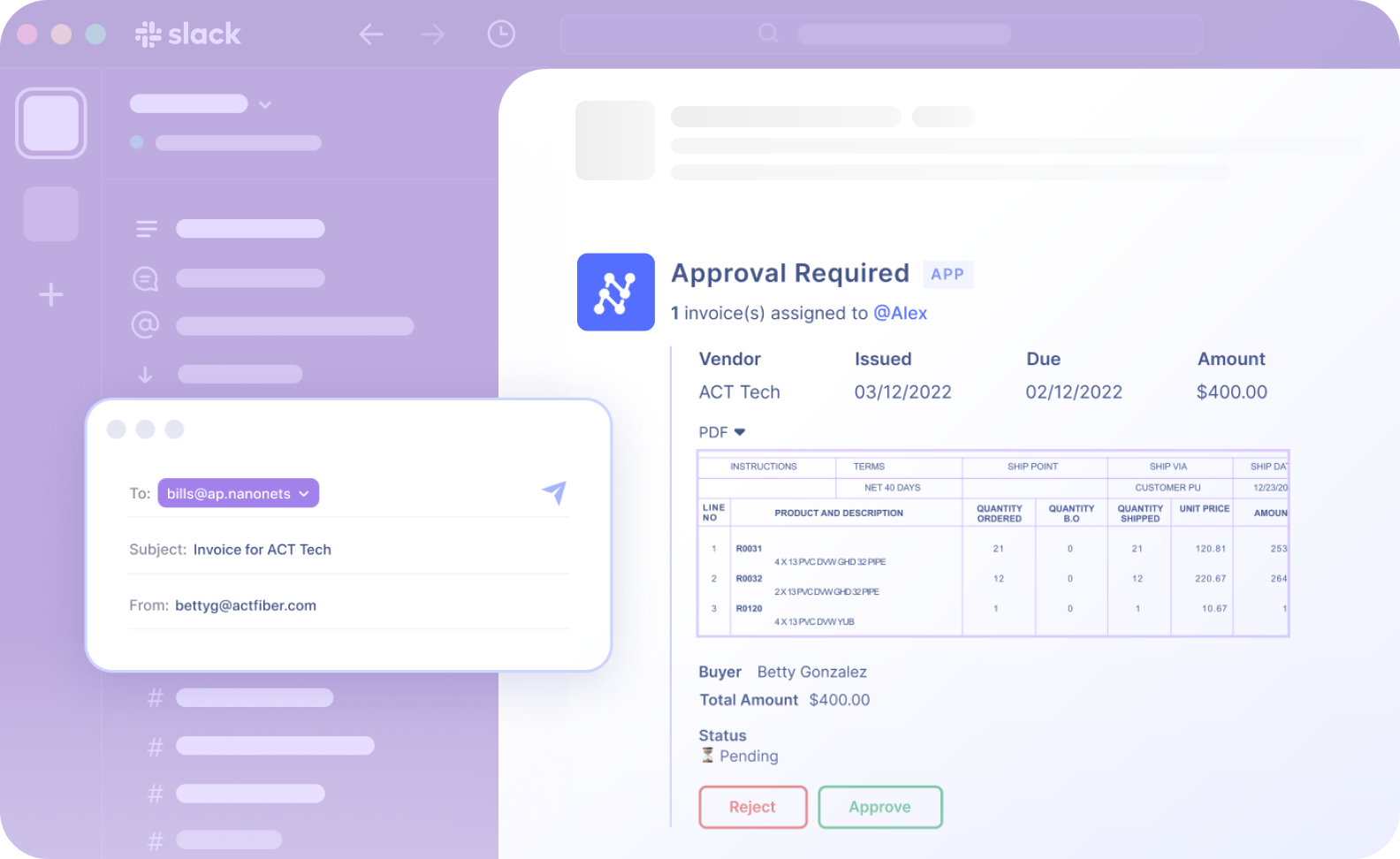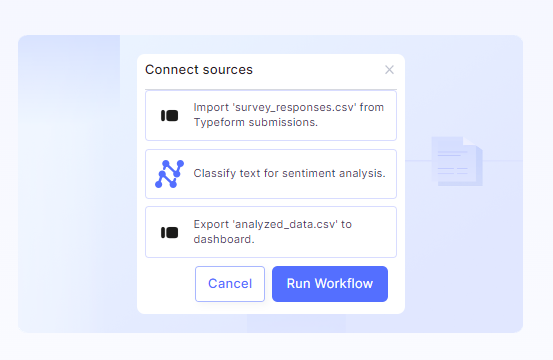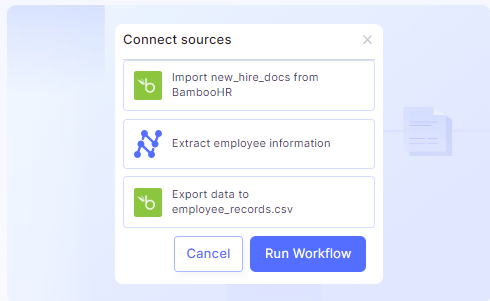AI data entry: How to get started?
It's a scene all too common around tax season — the accounting team huddled in a room, heads down, manually sifting through stacks of invoices, expense reports, and receipts and entering data into spreadsheets.
Wouldn't it be nice if their talent is spent on meaningful work that moves the needle? Unfortunately, it is not just isolated to accounting. A Zapier survey showed that 76% of employees spend up to 3 hours daily on data entry.
AI data entry powered by machine learning (ML) and natural language processing (NLP) can help change that scene. Organizations have reported a 95% reduction in data entry time after switching to robust automated data entry software. Let's delve deeper and explore how AI data entry functions, its key advantages, and some practical tips to keep in mind during implementation.
What is AI data entry?
Data entry powered by AI refers to using artificial intelligence technologies to automate extracting and inputting data into digital systems for further use.

Your team will no longer have to type information into forms, applications, or databases manually. And that’s only half of the story. A solid data automation solution can extract, classify, validate, and export data or auto-populate fields in other software systems.
That means not only is manual entry significantly reduced, but the entire pipeline of data handling becomes more streamlined.
The benefits of AI data entry
A 2020 McKinsey survey found that automation reduced costs by 10-15% and cut order processing time from 2-3 days to 1-2 hours. While this includes various automated systems, AI data entry is a major contributor to these efficiencies.
AI data entry ROI calculator
Nanonets PRO plan cost = $999/month
In case the number of pages goes beyond 10,000 in a month, an extra fee of $0.1 will be charged for each additional page.
Notes and assumptions (click to expand)
- This ROI calculation focuses solely on data entry-related costs and does not consider the costs of other tools or processes that may be in use.
- The calculation is simplified and excludes additional expenses such as supplies, storage, and potential processing delays.
- This calculation does not reflect the potential for increased revenue from reallocating employee time to higher-value tasks.
- Calculations are based on Nanonets' PRO plan, compared to the cost of manual entry
- The total cost after implementation includes the Nanonets subscription cost, the additional cost per page (if applicable), and the wages of one clerk to manage the system. This assumption may not accurately represent the situation for all businesses, especially larger ones with more complex document processing needs.
- By automating document processing, employees can focus on more meaningful and strategic work, improving job satisfaction and productivity. This benefit is not explicitly quantified in the ROI calculation.
- Consideration of larger ROI benefits from factors not included in this calculation is suggested.
- Nanonets offers a pay-as-you-go model suitable for smaller businesses or lower document volumes, with the first 500 pages free, followed by a charge of $0.3 per page.

Move at light speed with accurate data extraction, faster approval cycles, and seamless data flow between your business systems.
Let’s break down the specific benefits further:
1. Saves cost, time, and effort
Organizations have reported that AI data entry can automate up to 95% of repetitive data tasks. This frees up employee time for higher-value work.
For instance, financial data errors can cost over $800,000 in reworks every year, as per a Gartner report. However, businesses that have implemented automation have observed a remarkable 90% reduction in manual processing time spent on invoice data entry. This demonstrates how automation pays for itself many times over.
2. Improves data accuracy
From extracting vital financial figures for a quarterly report to capturing patient symptoms from clinical notes, accuracy matters tremendously in data entry. Even a tiny error can be costly. AI-OCR tools can provide an upwards of 95% accuracy rate.
Moreover, AI-OCR tools like Nanonets can seamlessly extract data from structured and unstructured documents. Terminologies, tax regulations, currency changes, language syntax, and more are quickly recognized and extracted accordingly.
3. Enables real-time data flow
Extracted and structured data from AI systems can connect directly to other platforms through APIs. This ensures real-time, synchronized data across sales, marketing, and operations — enhancing cross-departmental workflow efficiency and analytics and reporting.
For instance, customer order data from forms submitted on a website can automatically pre-populate the corresponding fields in CRMs, inventory management, and accounting systems.
~ Luke Faulkner, Product Manager at Tapi, on how Nanonets has impacted the company.
4. Scales easily
AI data entry solutions can ingest data from thousands of documents daily without losing steam. Be it from an email inbox, a shared folder, website form submissions, or scanned copies, the ability to scale infinitely is a strong advantage.
What's more, these systems learn from each use. So, the more it's used, the more refined and accurate it becomes. For industries grappling with immense data, such as healthcare and finance, it's a game changer.
5. Streamlines workflows
AI data entry solutions integrate seamlessly into existing IT infrastructure through APIs. This removes friction and structural bottlenecks in data pipelines between systems. For example, invoice approval workflows can go from 5 process steps to 2 by cutting manual handoffs.
Beyond just data entry, AI solutions like Nanonets can classify documents and route them to relevant teams automatically. For example, a scanned supplier invoice received in the accounting email can automatically get categorized, data extracted, posted in the ERP, and approval notification sent.

Implementing AI data entry: Applications and best practices
Let's face it — manually moving data into spreadsheets is about as fun as watching the paint dry. It can get mind-numbing, especially when you’re asked to do it day in and day out — it makes you more susceptible to errors. And this happens across the board. For instance, a recent study by EY revealed that payroll employees spend almost 29 weeks a year correcting the most common payroll errors.
Thankfully, now AI is advanced enough to automate capturing, classifying, and structuring data; it can optimize workflows and unlock major efficiency improvements. Let’s explore some of the most valuable applications of AI data entry and recommendations to ensure smooth adoption.
1. Process invoices, bills, receipts
Automating the processing of documents like invoices, bills, and receipts can save countless hours for your workforce. Robust solutions can take care of the process end-to-end, with you just overseeing final accuracy and authorizing payments.

With Nanonets, all you’ve to do is select an AI model that suits your documents and then set up an auto-import option from wherever they are coming in — your email inbox, a cloud storage folder, or even a physical scanner. If you only have a handful of documents, you can upload them manually.

After that, the AI captures the information, validates it, and sends it for approval. You can then review and approve the data in a central hub. You can export it as an Excel file or directly send it to your accounting software, ERP, or other systems.
2. Turn form submissions into actionable data
If you’re running a small designer boutique, you may collect orders via the Typeform link embedded in your Instagram bio or via a form on your Webflow website.

With Nanonets, these form submissions can be turned into actionable data. The Zapier integration allows you to extract and push everything directly from the customer's name, contact information, product choice, style preferences, and delivery details into your CRM, sales, or delivery management software.
Sales orders can be immediately picked up. The specifics of each order will be noted and delivered to your inventory management system. It allows you to provide a more personalized customer experience, streamlining operations and improving responsiveness.
3. Automate customer profile updates
Profile data is critical, whether it is a patient’s medical history in a hospital or a customer’s driving record in a car rental company. You can’t expect the customer or a patient to fill out long, tedious forms each time.

Utilizing Nanonets, you can scan documents they submit — new test reports and driving licenses — and immediately update the profile data without involving frontline staff. The AI can extract data from these documents and classify and update the information directly in your CRM, EMR, or proprietary software.

This saves your customers from the frustration of constantly filling out forms and your staff from mind-numbing data entry tasks. It also ensures that data stays updated and always available, helping you provide better customer experiences.
4. Manage vendor and supply chain documentation
Supply chain and vendor management often involve dealing with large amounts of documentation: purchase orders, quotations, invoices, contracts, delivery receipts, and more. Nanonets can automate the extraction and classification of data from these complex documents.

Purchase orders can be scanned to capture line item descriptions, pricing, delivery schedules, and more. Currency amounts, tax details, and payment deadlines can be pulled from complex vendor invoices. Delivery receipts can reveal shipment contents and tracking IDs for logistics visibility.
It can also interpret document formats, currency types, languages, and legal terminologies. Also, Nanonets allows documents to be processed as soon as they arrive — ensuring timely updates even during holidays, late nights, or other non-business hours.
5. Optimize parsing and verification workflows
HR and marketing teams often grapple with processing large volumes of data from sources like resumes, feedback surveys, and campaign analytics. AI tools like Nanonets can automatically parse these unstructured datasets to extract the required details.

For HR, it could mean capturing skills and experience information from resumes or validating details from identity documents. For marketing teams, it could capture customer sentiment from surveys or lead capture data that could be handed over to the sales team.

The extracted data can flow seamlessly into ATS, CRMs, or marketing automation platforms. This eliminates tedious manual efforts, minimizes errors, and allows employees to focus on strategic analysis.

AI data entry best practices
AI data capture and entry have tremendous potential, but implementation takes forethought and strategic planning. Following best practices ensures your rollout proceeds smoothly and you fully leverage capabilities over the long term.
1. Start with smaller pilots
Before integrating AI across your entire system, start with smaller-scale pilot projects. This way, you can better understand the AI's capabilities and rectify any issues before a full-scale launch.
For instance, you can start with expense claim reconciliation or converting customer survey responses into actionable data points. Track effectiveness and address feedback before leading into larger projects.
2. Prioritize AI implementation
Consider the areas where AI can deliver your organization's most immediate or substantial benefits. Perhaps invoice processing is incredibly time-consuming, or missing data from customer interactions is costing your sales team. Prioritize these areas when implementing AI.
3. Clean up existing data sources
Ensure that your existing data is cleaned and optimized. Because you’ll have to train the AI models using this data. If the data is messy or incorrect, it may lead to inaccurate AI outputs. Regular data cleaning can enhance AI's performance and improve its decision-making ability.
4. Set up and monitor KPIs
Specify KPIs like average time to process an invoice, order to cash cycles, customer response times, customer complaints regarding data errors, etc. Monitor these metrics before, during, and after the implementation of AI. This would help you objectively evaluate AI's impact on your operations.
5. Train, validate, and refine the model
First, use diverse sample documents to train the algorithm initially. Verify early-stage outputs, define key accuracy KPIs, and enable human validation scenarios where needed.
As new document templates and terminology emerge, continuously retrain the model and incrementally refine processing workflows to boost precision. Monitoring accuracy metrics and iterating on the AI will maintain the relevance and trustworthiness of automation.

Choosing the right AI data entry solution
Selecting the right AI-powered data entry automation solution for your business needs careful evaluation. Here is a checklist of critical criteria to consider:
☑️ Integrates with your tech stack
- Does the solution allow easy integration with your existing IT infrastructure through APIs?
- Can it export data directly into your databases, ERPs, or other platforms?
☑️ Accuracy and effectiveness
- Does it leverage advanced AI and machine learning for data extraction?
- What accuracy rates does it achieve in testing based on your sample documents?
- Does it provide transparency around confidence scores?
☑️ Customization ability
- Can you train custom models tailored to your unique document templates?
- Does it allow configuring specific data fields for capture as per your needs?
☑️ Scales up and down
- Can it handle spikes in your document volumes without losing accuracy?
- How quickly can documents be processed without latency issues?
☑️ Secures your sensitive data
- Does the vendor provide enterprise-grade data security?
- Can your sensitive business data be encrypted in transit and at rest?
☑️ Pricing and support
- Is pricing aligned with the value derived from automation?
- Is responsive customer support available across implementation cycles?
Final thoughts
The days of manual data entry are over. Modern automation solutions present a great chance to hand over the drudgery to AI. Now, your team can focus on meaningful work that moves the needle.
With Nanonets, you can automate repetitive data entry tasks with accuracy. And thanks to seamless integrations, data flows directly between your systems in real time. This means happier employees, delighted customers, and a competitive edge. Try out Nanonets today for free.

FAQs
Is there AI for data entry?
Yes, Nanonets leverages AI-powered optical character recognition (OCR) to automate data extraction from documents. For example, Nanonets can scan supplier invoices and automatically pull vendor names, amounts due, and payment terms into a structured format. This eliminates manually typing the data into your accounting system.
Will data entry be replaced by AI?
AI data entry solutions like Nanonets will significantly reduce the need for manual data entry but may not completely replace humans. Humans will still be needed to train AI models, validate outputs, handle exceptions, and make judgment calls.
Can you automate data entry?
Absolutely. With Nanonets, you can build no-code automation to extract data from documents and webpages and then flow it directly into databases, Excel, ERP platforms, etc. For instance, scanned delivery receipts can automatically capture shipment details like tracking IDs, contents, and dates into inventory management software.
How do I automate data entry in Excel?
AI-powered automation tools like Nanonets can seamlessly integrate with Excel, allowing you to populate spreadsheets with extracted data automatically. For example, customer feedback captured in Typeform surveys can be automatically structured and pushed into Excel -- no manual copying-pasting is needed. Just set up Nanonets, build automation workflows, and export data in one click.





















































